
Barrow-in-Furness is a port town and civil parish in the Westmorland and Furness district, in the ceremonial county of Cumbria, England. Historically in Lancashire, it was incorporated as a municipal borough in 1867 and merged with Dalton-in-Furness Urban District in 1974 to form the Borough of Barrow-in-Furness. In 2023, the borough merged with Eden and South Lakeland districts to form a new unitary authority: Westmorland and Furness. At the tip of the Furness peninsula, close to the Lake District, it is bordered by Morecambe Bay, the Duddon Estuary and the Irish Sea. In 2021, Barrow's population was 55,489, making it the second largest urban area in Cumbria after Carlisle, and the largest in the Westmorland and Furness unitary authority.
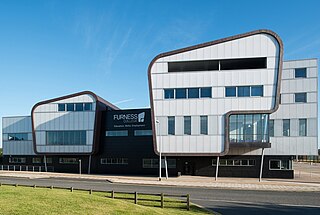
Furness College is a college of further education in Barrow-in-Furness, Cumbria. It provides a wide range of A levels, vocational education and skills training to over 16s, notably working with BAE Systems to train apprentices for their shipyard in Barrow. The college also offers courses for adults, and runs HNDs and other higher education programmes including foundation degrees, degrees and master's degrees, for which it achieved Teaching Excellence Framework silver status in June 2017. It is the only college in Barrow and the largest further education college in Cumbria. On 1 August 2016, Furness College merged with Barrow Sixth Form College.

Barrow Sixth Form College, part of Furness College, is in the outskirts of Barrow-in-Furness, Cumbria, England. Barrow Sixth Form College was established in 1979 to fulfil the role of the main A level provider in Barrow following the merger of the two Barrow Grammar Schools and their change to deliver education to only 11 to 16 year-olds. It is the only sixth form college in Cumbria. A levels and Cambridge Technical qualifications are taught in buildings that have been specially designed for students over the age of sixteen. It includes facilities for physically disabled students and is a satellite campus for Beaumont. The college primarily educates students within the age range of 16–18 years, as well as courses for adult learners.
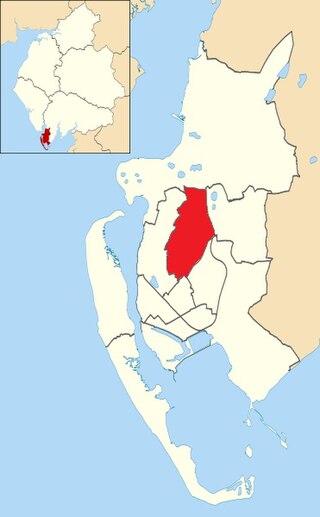
Hawcoat is an area and electoral ward of Barrow-in-Furness, Cumbria, England. Historically part of Lancashire, it is one of Barrow's most northerly wards and is bordered by Roose, Newbarns, Parkside, Ormsgill and the town of Dalton-in-Furness to the north.

The 2002 Barrow-in-Furness Legionnaires' disease outbreak was a fatal outbreak of Legionellosis which occurred in Barrow-in-Furness, Cumbria, England. It was and still remains among the worst such outbreaks in history.

Abbey Road is the principal north to south arterial road through Barrow-in-Furness, Cumbria, England.

Devonshire Dock is the oldest of the four docks which make up the Port of Barrow in Barrow-in-Furness, England. Although the dock falls under the control of Associated British Ports it is currently solely utilised by BAE Systems. Upon completion of the dock, Prime Minister William Ewart Gladstone stated 'Barrow would one day become another Liverpool'. Although its shipbuilding capabilities have exceeded those on Merseyside, the port and dock system itself never fully met James Ramsden's grand vision for the town.
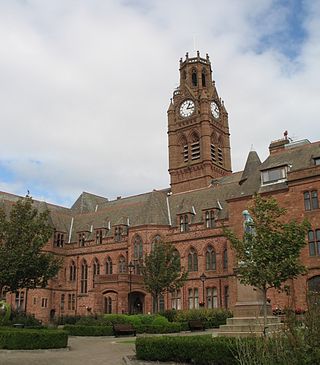
Barrow-in-Furness Town Hall is a Gothic Revival style municipal building in Barrow-in-Furness, Cumbria, England. The building, which served as the headquarters of the former Barrow Borough Council, and now one of the bases of Westmorland and Furness Council, lies within a Conservation Area with Grade II* listed status.

Craven House is a large office building in Barrow-in-Furness, Cumbria, England located on Michaelson Road close to the eponymous bridge. Constructed in the 1960s the building is noted for its length of roughly 90 m (300 ft) and consists of seven floors making it one of the tallest storied buildings in the town. The gross floor area stands at around 8,100 square metres (87,000 sq ft). Craven House is owned by the Department of Work and Pensions through Barrow Borough Council and currently houses the town's principal Jobcentre alongside leasing office space to the headquarters of successful shipping company James Fisher & Sons - the only Barrow based company listed on the London Stock Exchange.

Furness Academy is a secondary school in Barrow-in-Furness, England. It is the fourth academy to have been formed in the county of Cumbria after the closure of Alfred Barrow School, Parkview Community College of Technology and Thorncliffe School in 2009. Having utilised numerous buildings of the former Parkview and Thorncliffe Schools since 2009, a single £22 million building opened in the Parkside area of the town in September 2013.
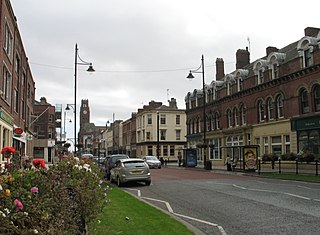
Duke Street is a road running through the town centre and Hindpool area of Barrow-in-Furness, England. Stretching almost one mile from east to west it connects two major A roads as well as intersecting Abbey Road roughly midway. Designed by Sir James Ramsden as the centrepiece of the 19th century planned town of Barrow, Duke Street is home to three squares alongside many listed buildings including Barrow Town Hall and the Main Public Library. The Forum performing arts centre and Craven Park Stadium are also located on Duke Street.

The Furness Abbey Hotel was demolished in 1953, having been bombed in May 1941. Its site now forms the car park to Furness Abbey and the museum. The station at Furness Abbey also suffered bomb damage and was demolished in the early 1950s. The original station booking office and refreshment room, built in 1862, which had been attached to the hotel, survives as The Abbey Tavern, standing in Abbey Approach, Barrow-in-Furness, Cumbria, England, to the north of the remains of Furness Abbey. The current structure is recorded in the National Heritage List for England as a designated Grade II listed building.

The John Whinnerah Institute is a Grade II listed Art Deco building and former educational establishment located on Abbey Road in Barrow-in-Furness, England. Having been constructed between 1937 and 1938 on the site of the demolished Jute Works it is the newest listed structure in the town, despite this it was drastically altered in 2004 when the entire interior was demolished to accommodate new retail units leaving only the Abbey Road and Hindpool Road facades.

Cooke's Building is a Grade II listed building located at 104 Abbey Road in Barrow-in-Furness, Cumbria, England. Designed by Howard Evans for businessman Henry Whiteside, Cooke's Building was built in 1875 and contains five-storey building. It served as a furniture store for the majority of its history up until 1959 when its owners; 'H Cooke and Sons' entered liquidation. During the 1980s and 1990s, Cooke's Building's basement level was home to the Sub Zero nightclub, however lay vacant during the 2000s. In 2012, a £2 million renovation was completed on behalf of Barrow Borough Council and Signal Films, who are now primary tenants of Cooke's Building using it as studios and offices. The building is bound by two other Grade II listed buildings – The Duke of Edinburgh Hotel and Oxford Chambers, the latter of which was formerly jointly listed with Cooke's Building.
St. George's Square, in Barrow-in-Furness, Cumbria, England is a public space that acted as the centre of the town during the late 19th century. The square now lies in the southernmost fringes of the Central ward close to the Port of Barrow.

Oxford Chambers is a Grade II listed building located on Abbey Road in Barrow-in-Furness, Cumbria, England. Oxford Chambers was constructed in 1875 with the intention of it functioning as a commercial property, however the new town's first higher grades school opened within the building in 1880. The school relocated to a larger premises on Duke Street in 1889. A notable feature of the building is a sign reading 'Central Cigar Depot', it also housed a shop selling office supplies in the late 20th century. Despite this, it is most known for containing the extension of the adjacent Travellers Rest social club. Oxford Chambers lies at the very northern perimeter of the Central Barrow conservation area close to The Duke of Edinburgh Hotel and the neighbouring Cooke's Building.
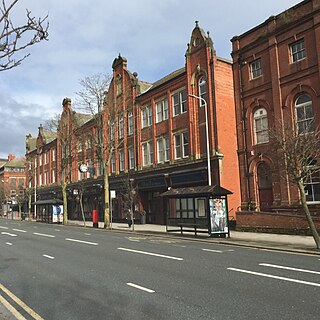
The Co-operative Building on Abbey Road in Barrow-in-Furness, Cumbria, England is a former department store. Constructed by the Barrow Co-operative Society in 1889 and expanded in 1902 it served as the town's largest such shop up until closure in 1996. Pub operator Wetherspoon opened a venue in the ground floor of the former Co-op Building in 1998 named after the Furness Railway and in 2015 converted the vacant upper floors of the building into a 52-bedroom hotel.
Schneider Square is a square located at the intersection of Duke Street, Dalton Road, Michaelson Road, Burlington Street and Fisher's Yard in Barrow-in-Furness, Cumbria, England. Schneider Square has changed little since its construction in the mid-19th century and now lies within a conservation area. Named after Henry Schneider who played a major role in the development of Barrow, there is a statue commemorating the industrialist in the centre of the square. Located on, or immediately adjacent to Schneider Square are Barrow Town Hall, Craven House, former Barrow Higher Grade School, Hotel Majestic, Burlington House and Duke Street Surgery.

Piel railway station was the terminus of the Furness Railway's Piel Branch in Barrow-in-Furness, England that operated between 1846 and 1936. Located on Roa Island it was built to serve the passenger steamers at Piel Pier. The Roa Island causeway was specifically constructed for the railway, in turn making the island part of the British mainland. The station and the Piel Branch line have both been demolished, however the Roa Island Hotel which was built adjoining the station survives to this day as a Grade II listed building.

The Imperial Hotel located on Cornwallis Street in Barrow-in-Furness, Cumbria, England is a 4-star Grade II listed hotel built in 1875. The iconic five storey building was designed by architect Thomas Bennet and, like many Barrow buildings, constructed of red brick and sandstone. Other notable features of the building are the balcony located directly above the main entrance and the two decorative lamps standing in front of the hotel, which are also Grade II listed.

















